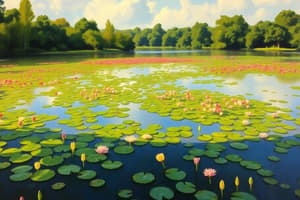Podcast
Questions and Answers
What is the term for the natural environment in which an organism lives, including living and non-living factors?
What is the term for the natural environment in which an organism lives, including living and non-living factors?
- Environmental factor
- Ecosystem
- Ecological niche
- Habitat (correct)
What are the non-living components of the environment?
What are the non-living components of the environment?
- Abiotic factors (correct)
- Ecological niches
- Biotic factors
- Habitats
What is the specific role an organism plays in its environment?
What is the specific role an organism plays in its environment?
- Habitat
- Ecological niche (correct)
- Environmental factor
- Adaptation
What is the process by which an organism becomes better suited to its environment?
What is the process by which an organism becomes better suited to its environment?
What is an example of a mutualism?
What is an example of a mutualism?
What is the term for the benefits provided by functioning ecosystems?
What is the term for the benefits provided by functioning ecosystems?
What is an example of a provisioning service?
What is an example of a provisioning service?
What is an example of a regulating service?
What is an example of a regulating service?
What is an example of a cultural service?
What is an example of a cultural service?
Flashcards are hidden until you start studying
Study Notes
Environment and Life
Habitat
- A habitat is the natural environment in which an organism lives, including living and non-living factors
- Examples of habitats: deserts, rainforests, oceans, grasslands, and more
Ecological Niche
- An ecological niche is the specific role an organism plays in its environment
- Includes the organism's diet, predators, prey, and interactions with other species
Environmental Factors
- Abiotic factors: non-living components of the environment, such as:
- Temperature
- Light
- Water
- Soil
- Air
- Biotic factors: living components of the environment, such as:
- Other organisms
- Predators
- Prey
- Competitors
- Symbionts
Adaptation
- The process by which an organism becomes better suited to its environment
- Examples of adaptations:
- Desert plants with deep roots to access water
- Arctic animals with thick fur to conserve heat
- Camouflage to avoid predators
Interdependence
- The relationships between different species in an ecosystem
- Examples of interdependence:
- Mutualism: clownfish and sea anemone
- Commensalism: remora fish and sharks
- Parasitism: tapeworms and their hosts
Ecosystem Services
- The benefits provided by functioning ecosystems, including:
- Provisioning services: food, water, and other resources
- Regulating services: climate regulation, pollination, and pest control
- Cultural services: recreation, tourism, and spiritual values
- Supporting services: nutrient cycling, soil formation, and primary production
Environment and Life
Habitat
- Natural environment in which an organism lives, including living and non-living factors
- Examples: deserts, rainforests, oceans, grasslands, and more
Ecological Niche
- Specific role an organism plays in its environment
- Includes: diet, predators, prey, and interactions with other species
Environmental Factors
Abiotic Factors
- Non-living components of the environment
- Examples: temperature, light, water, soil, air
Biotic Factors
- Living components of the environment
- Examples: other organisms, predators, prey, competitors, symbionts
Adaptation
- Process by which an organism becomes better suited to its environment
- Examples: desert plants with deep roots, Arctic animals with thick fur, camouflage to avoid predators
Interdependence
- Relationships between different species in an ecosystem
- Examples: mutualism (clownfish and sea anemone), commensalism (remora fish and sharks), parasitism (tapeworms and hosts)
Ecosystem Services
- Benefits provided by functioning ecosystems
Provisioning Services
- Food, water, and other resources
Regulating Services
- Climate regulation, pollination, pest control
Cultural Services
- Recreation, tourism, spiritual values
Supporting Services
- Nutrient cycling, soil formation, primary production
Studying That Suits You
Use AI to generate personalized quizzes and flashcards to suit your learning preferences.




